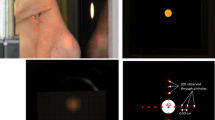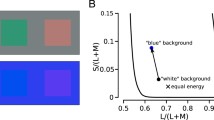Abstract
Purpose: Electrophysiological investigations of the short-wavelength sensitive pathway of the human eye require the use of a suitable light source as a S-cone stimulator. Different light sources with their spectral distribution properties were investigated and compared with the ideal S-cone stimulator. Methods: First, the theoretical background of the calculation of relative cone energy absorption from the spectral distribution function of the light source is summarized. From the results of the calculation, the photometric properties of the ideal S-cone stimulator will be derived. The calculation procedure was applied to virtual light sources (computer generated spectral distribution functions with different medium wavelengths and spectrum widths) and to real light sources (blue and green light emitting diodes, blue phosphor of CRT-monitor, multimedia projector, LCD monitor and notebook display). The calculated relative cone absorbencies are compared to the conditions of an ideal S-cone stimulator. Results: Monochromatic light sources with wavelengths of less than 456 nm are close to the conditions of an ideal S-cone stimulator. Spectrum widths up to 21 nm do not affect the S-cone activation significantly (S-cone activation change < 0.2%). Blue light emitting diodes with peak wavelength at 448 nm and spectrum bandwidth of 25 nm are very useful for S-cone stimulation (S-cone activation ≈95%). A suitable display for S-cone stimulation is the Trinitron computer monitor (S-cone activation ≈87%). The multimedia projector has a S-cone activation up to 91%, but their spectral distribution properties depends on the selected intensity. LCD monitor and notebook displays have a lower S-cone activation (≤ 74%). Conclusion: Carefully selecting the blue light source for S-cone stimulation can reduce the unwanted L- and M-cone activation down to 4% for M-cones and 1.5% for L-cones.
Similar content being viewed by others
References
Hart WM. Acquired dyschromatopsias. Surv Ophthalmol 1987; 32(1): 10–31.
Estévez O, Spekreijse H. The ‘silent Substitution’ method in visual research. Vision Res 1982; 22: 681–91.
Straub W, Kroll P, Küchle HJ. Augenärztliche Untersuchungsmethoden. Stuttgart: Enke, 1995.
Hunt RWG. Measuring Color. 2nd ed. Ellis Horwood series in applied science and industrial technology, 1995.
Lang H. Farbwiedergabe in denMedien: Fernsehen, Filmund Druck. Göttingen: Muster-Schmidt, 1995.
Jägle H, Albrecht JF, Baseler HA, Seeliger M, Sharpe LT. S-cone topography in normals and blue-cone monochromats. XXXIV ISCEV Symposium, St John's College, Sydney, Australia, 13-17 February 2000, abstract book, p. 53.
Sawusch M, Pokorny J, Smith VC. Clinical electroretinography for short wavelength sensitive cones. Invest Ophthalmol Vis Sci 1987; 28: 966–974.
Greenstein VC, Hood DC, Ritch R, Steinberger D, Carr RE. S (blue) cone pathway vulnerability in retinitis pigmentosa, diabetes and glaucoma. Invest Ophthalmol Vis Sci 1989; 30(8): 1732–37.
Gouras P, MacKay CJ. Electroretinographic responses of the short-wavelength-sensitive cones. Invest Ophthalmol Vis Sci 1990; 31(7): 1203–9.
Gouras P, MacKay CJ, Roy M, Yamamoto S. Brain responses of short-wavelength cones. Clin Vision Sci 1993; 8(6): 519–27.
van Norren D, Padmos P. Human and macaque blue cones studied with electroretinography. Vision Res 1973; 13: 1241–54.
Niepel G, Dodt E. Pattern electroretinogram of the blue cones. Graefe's Arch Clin Exp Ophthalmol 1989; 227: 45–50.
Uji Y, Yokoyama M. Blue cone response in glaucomatous eyes studied with electroretinography. Mie Med J 1981; XXXI(1): 213–18.
Horiguchi M, Miyake Y, Kondo M, Suzuki S, Tanikawa A, Koo HM. Blue light-emitting diode built-in contact lens electrode can record human s-cone electroretinogram. Invest Ophtalmol Vis Sci 1995; 36(8): 1730–32.
Kelly JP, Fourman SM, Jindra L. Foveal color and luminance sensitivity losses in glaucoma. Ophthalmic Surgery and Lasers 1996; 27(3): 179–187.
Jünemann A, Korth M, Nguyen NX, Martus P. Die Untersuchung des blauempfindlichen VEPs beim primären Offenwinkelglaukom und beim Glaukomverdacht. Search on Glaucoma 1994; 2(4): 89–94.
Korth M, Nguyen NX, Jünemann A, Martus P, Jonas JB. VEP test of the blue-sensitive pathway in glaucoma. Invest Ophthalmol Vis Sci 1994; 35(5): 2599–2610.
Carpenter RHS, Robson JG. Vision Research: a practical guide to laboratory methods. Oxford University Press, 1999.
Stewart WC, Chauhan BC. Newer visual function tests in the evaluation of glaucoma. Survey of Ophthalmology 1995; 40(2): 119–135.
Sutter, E. Schutz vor optischer Strahlung: Laserstrahlung, inkohärente Strahlung, Sonnenstrahlung. Berlin; Offenbach: VDE-Verlag, 1999.
Simonson SE, Rosenberg T. Reappraisal of a short-wavelength-sensitive (S-cone) recording technique in routine clinical electroretinography. Documenta Ophthalmologica 1996; 91: 323–332.
Stockman A, Sharpe LT. Cone spectral sensitivities and color matching. In: Gegenfurtner KR, Sharpe LT, eds. Color vision: from genes to perception. Cambridge: Cambridge Univ. Press, 1999: 53–87.
Schlegelmilch F, Tornow RP, Schellhorn K, Husar P, Henning G, Nolte R. Comparison of light sources for S-cone stimulation. Ophthalmic Research 2000; 32(2), p. 56.
Sample PA, Bosworth CF, Blumenthal EZ, Girkin C, Weinreb RN. Visual functionspecific perimetry for indirect comparison of different ganglion cell populations in glaucoma. Invest Ophthalmol Vis Sci 2000; 41(7): 1783–1790.
Drasdo N, Aldebasi YH, Chiti Z, Mortlock KE, Morgan JE, North RV. The S-cone PhNR and pattern ERG in primary open angle glaucoma. Invest Ophthalmol Vis Sci 2001; 42(6): 1266–1272.
Wyszecki G, Styles WS. Color science: concepts and methods, quantitative data and formulae. 2nd edition. New York, Chichester, Brisbane, Toronto, Singapore: John Wiley & Sons, 1982.
Keating D, Parks S, Evans A. Technical aspects of multifocal ERG recording. Doc Ophthalmol 2000; 100: 77–98.
Horn F, Korth M. Differences between pattern-evoked electroretinograms obtained by a scanning laser ophthalmoscope and by a mechanical mirror system. Doc Ophthalmol 1994; 88(1): 65–75.
Tornow RP. Stimulating multifocal ERG's using a scanning laser ophthalmoscope: differences to monitor-based systems. [ARVO abstract]. Invest Ophtalmol Vis Sci 1998; 39: p S972, #4488.
Tornow RP, Elsner AE, Moraes L, Kunze C. Stimulating multifocal ERG's (MF-ERG) using a scanning laser ophthalmoscope (SLO): effect of different laser-wavelength. [ARVO abstract]. Invest Ophthalmol Vis Sci 1999; 40(4): S16, #82.
Schlegelmilch F, Schellhorn K, Tornow RP, Husar P, Henning G. Visual evoked responses of cone isolated stimulation for objective perimetry. [ARVO Abstract]. Invest Ophthalmol Vis Sci. 2001; 42(4): S789; #4227.
Mollon JD, Baker MR. The use of CRT displays in research on colour vision. In Colour vision deficiencies XII Drum B ed. Dordrecht: Kluwer Academic, 1995: 423–44.
Bach M, Meigen T, Strasburger H. Raster-scan cathode-ray tubes for vision research - limits of resolution in spcae, time and intensity, and some solutions. Spatial Vision 1997; 10(4): 403–414.
Keller PA. Electronic display measurements: concepts, techniques and instrumentation. New York, Chichester, Weinheim, Brisbanem, Singapore, Toronto: John Wiley & Sons, 1997.
Stilling R. Einsatz der Scanning Laser Densitometrie und der Farbperimetrie zur Untersuchung der Netzhautfunktion bei Augengesunden und bei Patienten mit degenerativen Netzhauterkrankungen. Aachen: Shaker, 1999.
Kodak Wratten Gelatin Filter Transmission Curves. Kodak Photographic Filters Handbook. http://www.geocities.com/thombell/curves.html
Author information
Authors and Affiliations
Rights and permissions
About this article
Cite this article
Schlegelmilch, F., Nolte, R., Schellhorn, K. et al. Spectral characteristics of light sources for S-cone stimulation. Doc Ophthalmol 105, 339–363 (2002). https://doi.org/10.1023/A:1021271603178
Issue Date:
DOI: https://doi.org/10.1023/A:1021271603178




